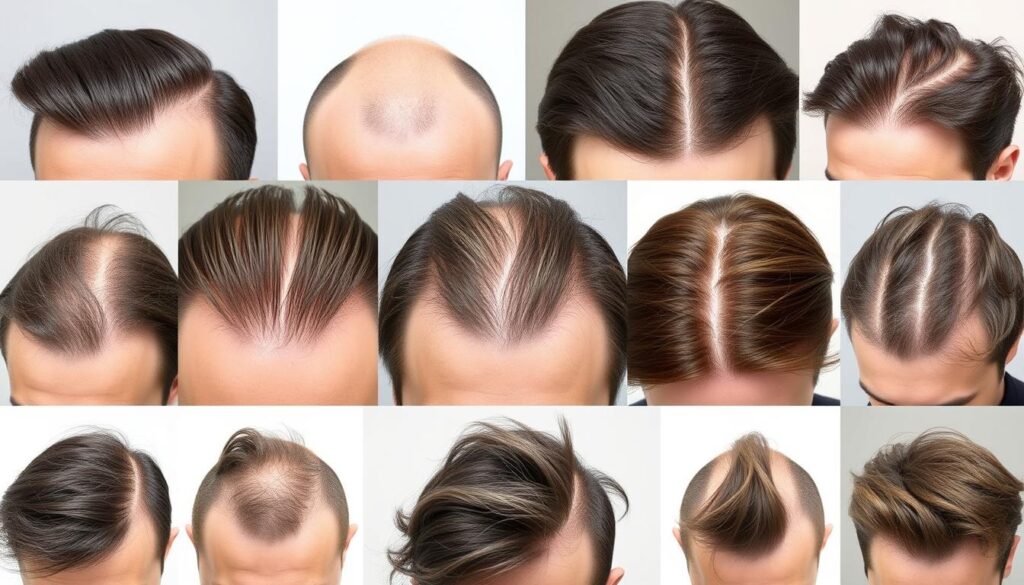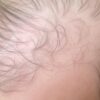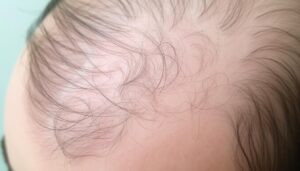Ever wonder if your hairline is normal? Or have you noticed thinning or shedding? This guide will cover different hairlines and hair loss causes. You’ll learn about your hair’s growth and how to keep it healthy and full.

Key Takeaways
- Discover the various types of hairlines, including bell-shaped and widow’s peak.
- Learn about the common causes of hair loss, such as genetics, aging, and medical conditions.
- Identify the early signs of thinning hair and explore effective solutions: Scalp Micropigmentation
Different types of hairlines and hair loss: What Is the Connection?
It’s key to know about the different kinds of hairlines to manage hair loss. There’s the classic straight hairline and unique shapes like the widow’s peak and M-shaped hairline. Each shape can change how your hair looks and grows.
The bell-shaped hairline is common and looks youthful. It’s curved at the temples. In contrast, the widow’s peak has a V-shape in the forehead, making it stand out.
The M-shaped hairline looks like an M at the temples. It might be due to genetics or early hair loss. The temples receding can make this shape.
A widow’s peak hairline has a triangular point in the forehead’s center. It’s a unique feature that adds character. While not as common as the bell-shaped, it’s a natural variation in hairlines.
Factors Contributing to Hair Loss
Genetics and Aging
Genetics can greatly affect hair loss. Androgenetic alopecia, or male/female pattern baldness, is a hereditary condition. It leads to hair thinning over time.
As we age, hair loss can also happen. This is because hair follicles become less active. The growth cycle slows down.
Medical Conditions and Medications
Certain medical conditions can cause hair loss. These include thyroid disorders, anemia, and autoimmune diseases. They disrupt the hair growth cycle, leading to shedding or thinning.
Some medications can also cause hair loss. This includes treatments for cancer, depression, and high blood pressure. Hair loss is a common side effect.
Identifying Early Signs of Hair Loss
It’s important to spot the early signs of hair loss by knowing different hairline types to act fast and keep your hair healthy. Look out for more shedding, thinning at the temples, or crown. These small changes can signal a bigger issue.
More hair in your brush or shower drain is a clear sign of thinning. If your hair looks thinner, especially at the temples or crown, it’s time to take action. These are signs of hair loss patterns that need attention.
Changes in hair texture, like dryness or brittleness, can also warn of hair loss. Pay close attention to how your hair feels and looks. These small changes can mean big problems.
Treatment Options for Thinning Hair
Scalp Micropigmentation
Scalp micropigmentation (SMP) has gained significant popularity in recent years as a non-invasive solution to address hair loss and create the appearance of a fuller head of hair. This innovative technique involves implanting tiny pigments into the scalp, replicating the look of hair follicles.
One of the most appealing aspects of SMP is its versatility, allowing for customization based on different types of hairlines. Whether someone is looking for a receding hairline, a youthful straight-across line, or a natural crown area, SMP offers the ability to tailor the result to suit individual preferences and blend seamlessly with existing hair. Understanding different hair line types helps discover what you want to get out of SMP.
Conclusion
Asking the right questions about scalp micropigmentation is crucial for a successful and satisfying experience. Here at ScalpMasters, we understand the importance of clear communication between clients and SMP artists.
Understanding your hair line can make the whole process smoother. Scalp Micropigmentation can help boost your confidence and maek you feel like yourself. Contact us today if you have any questions or want to schedule a consultaion!










